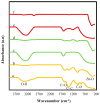Green Microwave-Assisted Combustion Synthesis of Zinc Oxide Nanoparticles with Citrullus colocynthis (L.) Schrad: Characterization and Biomedical Applications
- PMID: 28212344
- PMCID: PMC6155814
- DOI: 10.3390/molecules22020301
Green Microwave-Assisted Combustion Synthesis of Zinc Oxide Nanoparticles with Citrullus colocynthis (L.) Schrad: Characterization and Biomedical Applications
Abstract
In this paper, a green microwave-assisted combustion approach to synthesize ZnO-NPs using zinc nitrate and Citrullus colocynthis (L.) Schrad (fruit, seed and pulp) extracts as bio-fuels is reported. The structure, optical, and colloidal properties of the synthesized ZnO-NP samples were studied. Results illustrate that the morphology and particle size of the ZnO samples are different and depend on the bio-fuel. The XRD results revealed that hexagonal wurtzite ZnO-NPs with mean particle size of 27-85 nm were produced by different bio-fuels. The optical band gap was increased from 3.25 to 3.40 eV with the decreasing of particle size. FTIR results showed some differences in the surface structures of the as-synthesized ZnO-NP samples. This led to differences in the zeta potential, hydrodynamic size, and more significantly, antioxidant activity through scavenging of 1, 1-Diphenyl-2-picrylhydrazyl (DPPH) free radicals. In in vitro cytotoxicity studies on 3T3 cells, a dose dependent toxicity with non-toxic effect of concentration below 0.26 mg/mL was shown for ZnO-NP samples. Furthermore, the as-synthesized ZnO-NPs inhibited the growth of medically significant pathogenic gram-positive (Bacillus subtilis and Methicillin-resistant Staphylococcus aurous) and gram-negative (Peseudomonas aeruginosa and Escherichia coli) bacteria. This study provides a simple, green and efficient approach to produce ZnO nanoparticles for various applications.
Keywords: Citrullus colocynthis; Combustion method; ZnO nanoparticles; antimicrobial; antioxidant; green synthesis.
Conflict of interest statement
The authors declare no conflict of interest.
Figures











References
-
- Wang Z.L. ZnO nanowire and nanobelt platform for nanotechnology. Mater. Sci. Eng. R. 2009;64:33–71. doi: 10.1016/j.mser.2009.02.001. - DOI
-
- Pal B., Sharon M. Enhanced photocatalytic activity of highly porous ZnO thin films prepared by sol-gel process. Mater. Chem. Phys. 2002;76:82–87. doi: 10.1016/S0254-0584(01)00514-4. - DOI
-
- Wagner T., Waitz T., Roggenbuck J., Froba M., Kohl C.-D., Tiemann M. Ordered mesoporous ZnO for gas sensing. Thin Solid Films. 2007;515:8360–8363. doi: 10.1016/j.tsf.2007.03.021. - DOI
MeSH terms
Substances
LinkOut - more resources
Full Text Sources
Other Literature Sources
Miscellaneous

